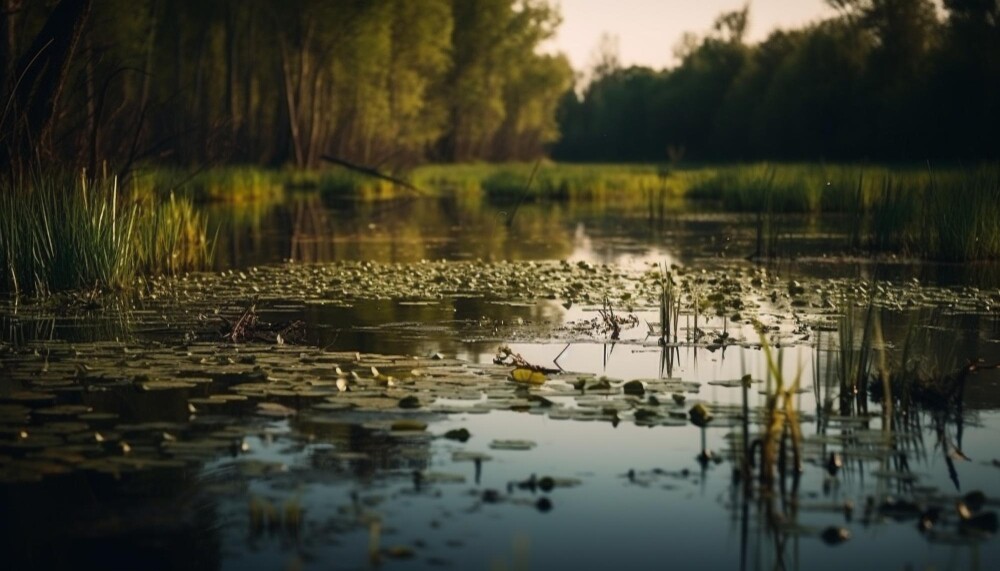
Florida Department of Environmental Protection
June 30 – July 6, 2023 – There were 31 reported site visits in the past seven days with 29 samples collected. Algal bloom conditions were observed by samplers at 20 of the sites.
Satellite imagery for Lake Okeechobee from 7/6 shows patches of low to high bloom potential on approximately 25% of the lake. Satellite imagery for the Caloosahatchee and St. Lucie estuaries from 7/6 shows no bloom potential on visible portions of either estuary; however, there were numerous harmful algal bloom (HAB) reports from the Caloosahatchee River and residential canals in Cape Coral and Fort Meyers area this past week.
Satellite imagery for the St. Johns River from 7/6 shows scattered low to moderate bloom potential on Lake George and the mainstem of the river down to Clarks Creek. Please keep in mind that bloom potential is subject to change due to rapidly changing environmental conditions or satellite inconsistencies (i.e., wind, rain, temperature or stage.)
DEP in coordination with its state and local partners extensively monitors and samples locations throughout Florida to evaluate water quality. Since January, DEP’s Division of Environmental Assessment and Restoration has performed over 782 site visits and more than 1,130 sets of cyanotoxin analyses at DEP’s state-of-the-art laboratory to protect public health and the environment. Learn more about the roles and responsibilities of the agencies within this network when responding to blue-green algal blooms as well as how local county health departments issue caution and health alert notices.
On 7/5-7/6, Florida Department of Environmental Protection (DEP) staff visited 24 locations and collected 22 HAB response samples. No blooms were observed and no samples were collected at the Caloosahatchee – Sebastian Ct and Caloosahatchee – Alva Boat Ramp locations. Dominant algal taxa and cyanotoxin results follow each waterbody name.
• Louise Lake – NW Lobe: Planktolyngbya limnetica; trace level (0.13 parts per billion [ppb]) microcystins detected.
• Caloosahatchee – End of SE 13th Ave: Sphaerospermopsis torques-reginae; no cyanotoxins detected.
• Caloosahatchee – Jaycee Park: Microcystis aeruginosa; 2.8 ppb microcystins detected.
• Caloosahatchee – End of Canal Cir: Microcystis aeruginosa; 2.5 ppb microcystins detected.
• Caloosahatchee – Whitecap Cir Dock: Microcystis aeruginosa; 3.2 ppb microcystins detected.
• Pioneer Lake – NE Shore: Microcystis aeruginosa; 0.45 ppb microcystins detected.
• Caloosahatchee – Coral Point Dr: Microcystis aeruginosa; 16.8 ppb microcystins detected.
• Bonita Lake – S Shore: Oedogonium sp.; trace level (0.26 ppb) anatoxin-a detected.
• C-107 at NW Volucia Drive: Oedogonium sp.; no cyanotoxins detected.
Results are pending for samples collected at Peace River – Veterans Park Ramp; Peace River – at Bartow; Peace River – Crews Park Boat Ramp; Peace River – Brownville; Peace River – at Fort Meade; Lake Apthorpe – Boat Ramp; Lake Hancock – South Central; Lake Okeechobee – Pahokee Marina; Lake Weir – Eatons Beach; Lake Okeechobee – S308C (lakeside); C44 canal – S308C (canal side); Lake Rowena – near NE corner; and Blue Lake – Western Shore.
On 7/5, South Florida Water Management District staff collected six HAB response samples.
• C43 Canal – S77 (upstream): No dominant algal taxon; no cyanotoxins detected.
• C43 Canal – S78 (upstream): No dominant algal taxon; no cyanotoxins detected.
• C43 Canal – S79 (upstream): No dominant algal taxon; no cyanotoxins detected.
• Lake Okeechobee – S271 (lakeside): Microcystis aeruginosa; 3.3 ppb microcystins detected.
• Lake Okeechobee – S352 (lakeside): Microcystis aeruginosa; 2.6 ppb microcystins detected.
• Lake Okeechobee – S354 (lakeside): Microcystis aeruginosa; 1.0 ppb microcystins detected.
On 7/6, Highlands County staff collected a HAB response sample at Lake Istokpoga. Results are pending.
Pending Results from Last Week
On 6/28-6/29, DEP staff collected HAB response samples at five sites. The samples for Caloosahatchee River – Harbor View Canal and Caloosahatchee River – Rubicon Canal were not received by the laboratory due to a shipping delay.
• Caloosahatchee River – Rivers Condo: No dominant algal taxon; no cyanotoxins detected.
• Georges Lake – Boat Ramp: Microcystis aeruginosa and Microcystis wesenbergii co-dominant.
• Caloosahatchee River – Overiver Dr: Microcystis aeruginosa; trace level (0.76 ppb) microcystins detected.
On 6/29, St. Johns River Water Management District staff collected one routine HAB monitoring sample at Lake Washington – Center and one HAB response sample at Bull Creek. The Lake Washington – Center sample was dominated by Dolichospermum circinale, and the Bull Creek sample was dominated by Microcystis aeruginosa. Neither sample had cyanotoxins detected.
Results for completed analyses are available at FloridaDEP.gov/AlgalBloom.
This is a high-level summary of the sampling events for the reported week. For all field visit and analytical result details, please refer to the complete algal bloom map with data table by clicking the “Field and Lab Details” Quick Link from the Algal Bloom Dashboard. Different types of blue-green algal bloom species can look different and have different impacts. However, regardless of species, many types of blue-green algae can produce toxins that can make you or your pets sick if swallowed or possibly cause skin and/or eye irritation due to contact. We advise staying out of water where algae is visibly present as specks or mats or where water is discolored pea-green, blue-green or brownish-red. Additionally, pets or livestock should not come into contact with algal bloom-impacted water or with algal bloom material or fish on the shoreline.